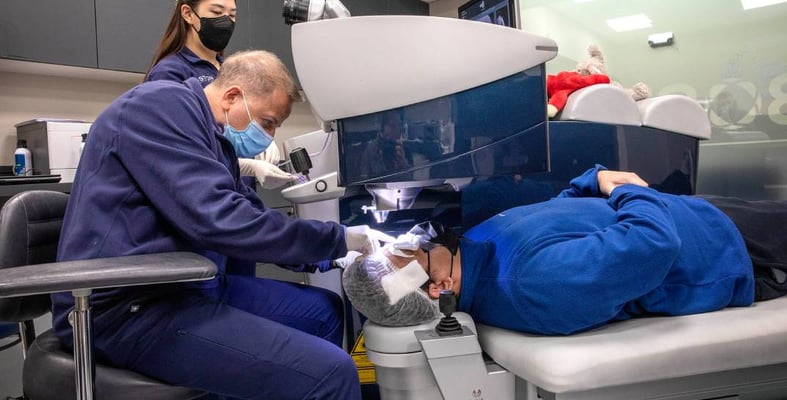LASIK Surgery for eyes

Laser-Assisted in Situ Keratomileusis (LASIK) has become the most commonly performed procedure among laser eye surgeries for correcting refractive vision problems, as it is considered an effective solution for farsightedness and myopia of all degrees, whether astigmatism was an associated problem or not.
What is lasik surgery for eyes?
LASIK procedure uses a special type of laser beam, called the excimer laser, or the ultraviolet laser to reshape the cornea so that the light can focus accurately on the retina and by doing so it can correct refractive errors such as, myopia (nearsightedness), hyperopia (farsightedness), and astigmatism, helping patients perform most of their daily activities without needing eyeglasses or contact lenses.
Excimer laser
The excimer laser has been developed over the past two decades for use in eye surgery for its distinctive and harmless properties on human tissues.
The laser is characterized by an excellent ability to break the bonds between the molecules within the corneal tissues, and because of the absence of any thermal damage to the neighboring tissues it is also called a cold laser beam.
The excimer laser is used to redesign the shape of the cornea in a highly accurate and computerized way according to the corneal topography.
Lasik eye surgery procedure steps
LASIK surgery involves opening the outer shell of the cornea with a high-precision scalpel without separating it, creating a flap of corneal tissue, after that the cornea is reshaped using the excimer laser according to the refractive error, and the flap is replaced the way it was, which speeds healing and reduces complications.
LASIK is a simple procedure that is done under mild sedation and not general anesthesia. LASIK procedure usually takes about 10 minutes to finish, and it does not necessitate admission to the hospital.
LASIK surgery is also performed without any surgical sutures, and when the patient is sent home, some medications are prescribed for him, such as steroid drops, a topical antibiotic, and painkillers.
lasik surgery benefits
LASIK surgery is characterized by the lack of pain after the operation, and the postoperative fast recovery, with the possibility of treating severe degrees of nearsightedness.
LASIK has proven its effectiveness and safety over the years, as both eyes can be treated within minutes, and in one day, the problems of hyperopia, myopia and astigmatism can be corrected without causing any complications or damage to the cornea.
Lasik eye surgery requirements
LASIK eye surgery does not work for everyone, as the age, the nature of the refractive error, and the presence of other associated diseases may prevent the patient from getting the desired results, so the eye surgeon has to evaluate how suitable LASIK is for each case. For example, the procedure is rarely successful in the elderly patient population.
What to do before lasik surgery
The surgeon thoroughly reviews the patient's medical and surgical history, and looks for any factors that may negatively affect the procedure to be performed or its results, such as immunodeficiency, autoimmune diseases, connective tissues diseases or vasculitis. The surgeon will also ask about any past history of eye surgery or disease, and it is also necessary to make sure there is no silent glaucoma or dry eye.
Contact Lenses
Contact lenses should not be worn for at least two weeks before the initial pre-operative evaluation.
Eye Examination
A comprehensive eye examination must be performed before the operation, and includes the following aspects:
Slit lamp examination, checking the size of the pupil, checking for dry eyes, measuring eye pressure, fundus examination, corneal examination.
Side effects after laser eye surgery
Like any surgical operation, LASIK has some complications and potential risks, the most important of which is the occurrence of some problems with the night vision, some brightness or glare, in addition to some of the following problems:
- Failure to treat the problem of myopia, hyperopia or astigmatism completely, but it is possible to do some adjustment in the period after the operation without having to repeat the procedure
- Dry eyes, the patient can use some special eye drops to relieve dryness.
- Inflammation or infection in the cornea, which occurs in 1 out of 2000 patients, but it is one of the most serious complications that can cause blindness.
long term results of lasik eye surgery
In several studies in which Lasik patients have been followed up for a period of 10 years, it has been observed that the problem of nearsightedness, farsightedness, or astigmatism has been corrected, and most of the patient were performing their daily activity without needing contact lenses or eyeglasses.
Questions and answers on laser vision correction
Do you have an inquiry? Contact us - For FREE Consultation.
Ilajak Medical©| A passion for care




Treatment Services
In the Best Medical Centers
Contact Us
Please fill the form below and describe your condition, We will contact you back
- Dental Treatment
- Hair Transplant
- Obesity Surgery
- Vision Correction
- Health Resorts
- Other Medical Services
- No elements found. Consider changing the search query.
- List is empty.
Your personal data is processed as indicated in the general statement text and by continuing, you explicitly consent to the processing

